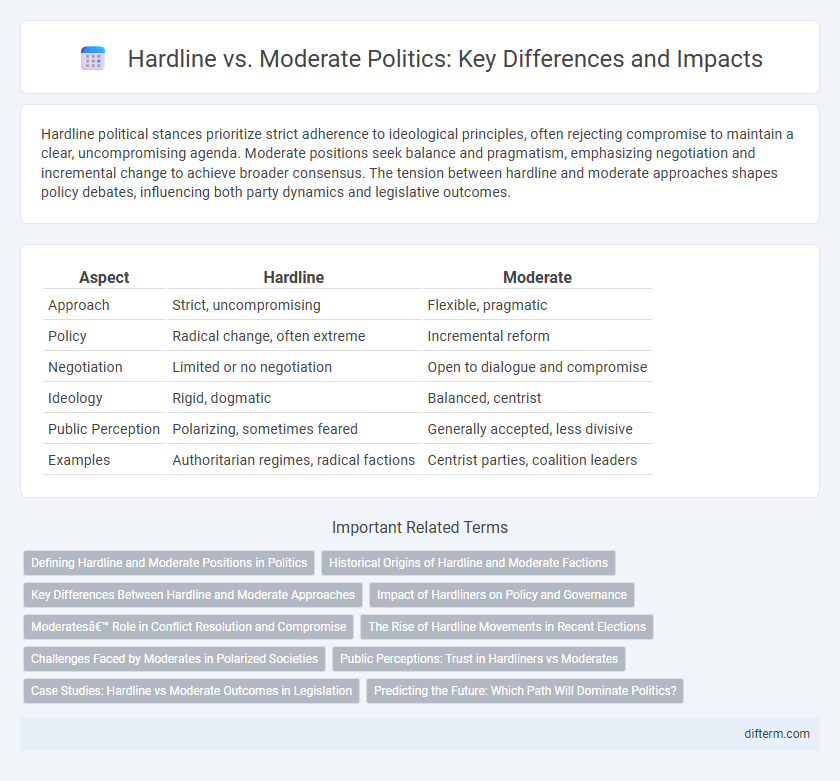Hardline political stances prioritize strict adherence to ideological principles, often rejecting compromise to maintain a clear, uncompromising agenda. Moderate positions seek balance and pragmatism, emphasizing negotiation and incremental change to achieve broader consensus. The tension between hardline and moderate approaches shapes policy debates, influencing both party dynamics and legislative outcomes.
Table of Comparison
| Aspect | Hardline | Moderate |
|---|---|---|
| Approach | Strict, uncompromising | Flexible, pragmatic |
| Policy | Radical change, often extreme | Incremental reform |
| Negotiation | Limited or no negotiation | Open to dialogue and compromise |
| Ideology | Rigid, dogmatic | Balanced, centrist |
| Public Perception | Polarizing, sometimes feared | Generally accepted, less divisive |
| Examples | Authoritarian regimes, radical factions | Centrist parties, coalition leaders |
Defining Hardline and Moderate Positions in Politics
Hardline political positions emphasize strict adherence to ideological principles, often advocating for uncompromising policies and strong enforcement measures, typically associated with conservative or radical factions. Moderate political positions seek balanced and pragmatic solutions, promoting dialogue, compromise, and incremental change to accommodate diverse perspectives within the political spectrum. Understanding these distinctions clarifies the spectrum of policy approaches and their impact on governance and social cohesion.
Historical Origins of Hardline and Moderate Factions
The hardline and moderate factions trace their origins to early political schisms during revolutionary movements where radical elements demanded sweeping reforms while moderates sought gradual change within existing structures. Hardliners often emerged from ideological purists committed to uncompromising principles, influencing parties such as the Bolsheviks in early 20th-century Russia. Moderates typically drew support from pragmatic leaders advocating compromise to maintain stability, as seen in factions during the French Revolution and U.S. political realignments.
Key Differences Between Hardline and Moderate Approaches
Hardline political approaches emphasize strict adherence to ideology, advocating for uncompromising policies and often prioritizing security or traditional values, which can lead to aggressive stances on issues such as immigration and national defense. Moderate approaches favor pragmatic decision-making, seeking balanced solutions through negotiation and compromise, aiming to accommodate diverse perspectives within a centrist framework. Key differences lie in their willingness to engage in dialogue, with hardliners rejecting concessions while moderates pursue consensus to maintain social stability and political flexibility.
Impact of Hardliners on Policy and Governance
Hardliners significantly influence policy and governance by pushing for stringent measures and uncompromising stances, often leading to polarized political environments and slowed legislative processes. Their emphasis on strict adherence to ideology can result in reduced diplomatic flexibility and heightened social tensions. This assertive approach frequently impacts governmental stability and international relations by prioritizing security and control over consensus-building.
Moderates’ Role in Conflict Resolution and Compromise
Moderates play a crucial role in conflict resolution by bridging the gap between hardline factions, fostering dialogue, and promoting pragmatic solutions that balance diverse interests. Their willingness to engage in compromise helps de-escalate tensions and create sustainable political agreements. Effective moderation often leads to policy stability and long-term peace in polarized political environments.
The Rise of Hardline Movements in Recent Elections
Hardline movements have surged in recent elections, driven by growing public discontent with establishment politics and economic instability. These movements emphasize strict policies on immigration, national security, and cultural identity, resonating with voters seeking decisive action. Electoral gains in countries like the United States, Brazil, and Hungary underscore the increasing influence of hardline factions in shaping political discourse and policy agendas.
Challenges Faced by Moderates in Polarized Societies
Moderates in polarized societies face significant challenges such as marginalization by both hardline factions and the electorate, reducing their political influence and ability to broker compromise. The pressure to conform to extreme positions undermines moderate voices, leading to decreased voter turnout and political disengagement among centrist constituents. These challenges hinder the development of balanced policies and fuel further societal division.
Public Perceptions: Trust in Hardliners vs Moderates
Public perceptions often reveal higher trust in moderates due to their perceived willingness to compromise and promote stability, which resonates with a broader electorate seeking pragmatic solutions. Hardliners, while admired by a core base for their firm stances and ideological consistency, face skepticism from undecided voters who view their approaches as rigid or polarizing. Polling data consistently highlights a trust gap favoring moderates, reflecting concerns over potential extremism and the desire for inclusive governance.
Case Studies: Hardline vs Moderate Outcomes in Legislation
Hardline politicians often push for stringent policies with swift implementation, resulting in polarized legislative outcomes that may provoke public backlash or judicial challenges. Moderate lawmakers tend to negotiate and compromise, producing more sustainable legislation with broader bipartisan support, as seen in cases like the Affordable Care Act versus the Tax Cuts and Jobs Act. These contrasting approaches impact policy durability, public acceptance, and long-term effectiveness in governance.
Predicting the Future: Which Path Will Dominate Politics?
Hardline political ideologies emphasize strict adherence to core principles and often resist compromise, appealing to constituents seeking decisive action on issues like national security and immigration. Moderate positions prioritize pragmatism and bipartisan cooperation, attracting voters who favor stability and incremental change in governance. Predicting which path will dominate politics depends on evolving public sentiment, socio-economic challenges, and the effectiveness of leadership in addressing urgent national and global concerns.
Hardline vs Moderate Infographic

 difterm.com
difterm.com